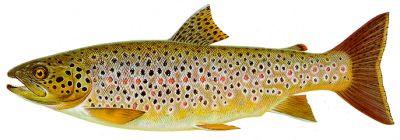
The Gillaroo Trout

|
A gillaroo: the gaudy Irish
'red feller' is one of the most spectacular brown trout varieties.
Its brassy coloration provides camouflage against rocks and
boulders in the shallow waters of lake margins. |
'On a background of satin wood are scattered spots and blotches of red, orange, umber, and burnt sienna, so thickly as to touch and, interfuse,' enthused T. C. Kingsmill Moore in A Man May Fish (1960). As the fish comes to the net, the impression can be well-nigh dazzling. To appreciate the richness of colour and complexity of patterning a quick look is not enough. You sit there in the boat, examining every spot, every line. Seeing how one shade merges into another. Poring over the fin markings. Scrutinising the subtle way that each individual scale contributes to the immaculate beauty of the whole.
The status of this highly distinctive fish has been the subject of argument for many years. Some have considered it to be a separate species: GŁnter gave the gillaroo the scientific name, Salmo stomachicus because of its supposedly specific stomach structure. As the Reverend Houghton put it in 1879, in British Fresh-Water Fishes, 'The muscular walls of the Gillaroo are so strong that they have been supposed to perform to a certain extent the function of a gizzard.'
The gillaroo has evolved this feature as an adaptation to its diet: mainly invertebrates of the lake bed, including a high proportion of freshwater snails and crustaceans. The thick muscular wall is used to grind up these very tough food items. However, many other forms of trout can develop a similar thickened stomach wall when feeding for a long period on similar foods. So it is no more unique as a characteristic than the intense red colour of the gillaroo's flesh caused by a high level of carotenolds in the diet.
There has been much debate as to whether the coloration of the gillaroo is primarily genetic or a product of the trout's diet and environment. A Queen's University of Belfast study of Lough Melvin has shown, for that lake at least, that the gillaroo is genetically isolated from the lake's other trout inhabitants, and that the progeny of gillaroos are always gillaroos. But no similar analysis of gillaroos from other lakes has been carried out.
However, a visual examination of gillaroos from Lough Conn and seven lochs in northwest Scotland has suggested that they may be closely related. Certainly, it would be very difficult to separate, on superficial characteristics alone, the gillaroos of Loughs Conn and Corrib, or Lochs Fadagoa, Mulach-Corrie and Assynt, either from each other or from those of Lough Melvin. Possibly they are all the progeny of one wave of trout that colonised the west of the British Isles from the Atlantic up to 10,000 years ago; and which because of their diet and behaviour have remained separate from other trout stocks ever since.
The gillaroo is generally a shallow water species, feeding close to the lake margins, around skerries and over rocky shelves, often in no more than a foot or so of water. In such niches it is well camouflaged despite its gaudiness: the bright patterning of the gillaroo merges into the flickering of sunlight on the boulder-strewn lake bed. Here the gillaroo browse the surface of rock and weed for snails, freshwater shrimps and hog-lice. They sift through the silt on the lake bed for caddisfly larvae, eating them case and all. Should there be a hatch of mayfly, or a fall of heather flies, they are not averse to rising the short distance to the surface to take them with a swirl.